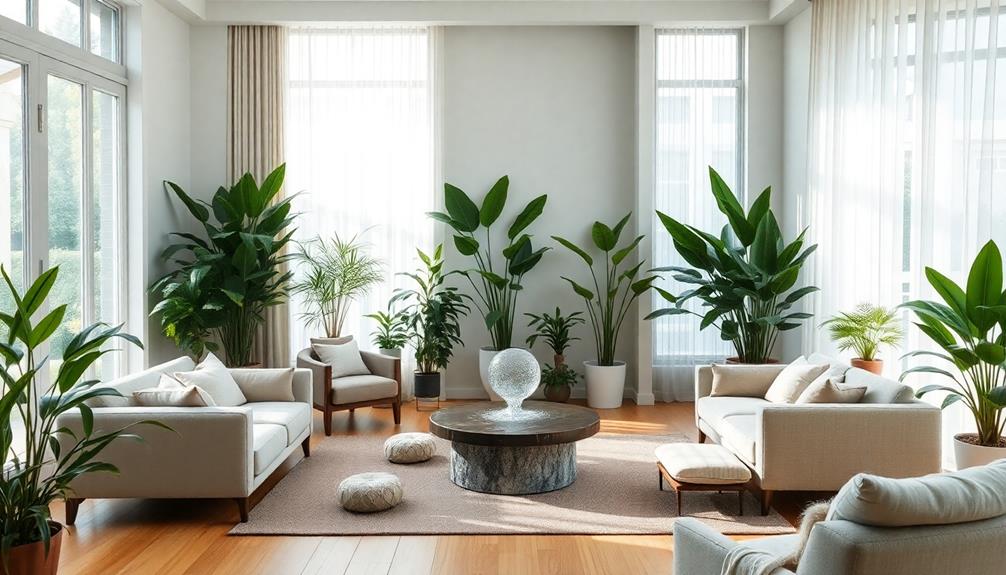Indonesian fabrics can truly transform your home decor into an explosion of color and culture. With stunning patterns and vibrant hues, textiles like Batik and Ikat not only beautify your space but also tell rich stories rooted in local traditions. Each piece carries unique meanings, from symbols of wealth to representations of spirituality. You can use these fabrics in various ways—think luxurious wall hangings, eye-catching throws, or unique upholstery to enhance any room. By incorporating these breathtaking textiles, you invite a touch of Indonesian artistry into your home. If you're intrigued, there's much more to explore about these exquisite fabrics.
Key Takeaways
- Indonesian fabrics like Batik, Ikat, and Songket add vibrant colors and intricate designs to enhance any home decor style.
- The cultural significance of these textiles reflects local history, artistry, and community values, making them meaningful decor choices.
- Batik features various types, such as Batik Tulis and Batik Cap, offering unique options for customization and personalization in decor.
- Ikat's resist-dyeing technique provides unique textures, suitable for upholstery, curtains, and accent pillows, creating bold focal points.
- Sourcing authentic Indonesian fabrics supports local artisans and ensures quality craftsmanship, enriching your home with cultural heritage.
The Allure of Indonesian Fabrics
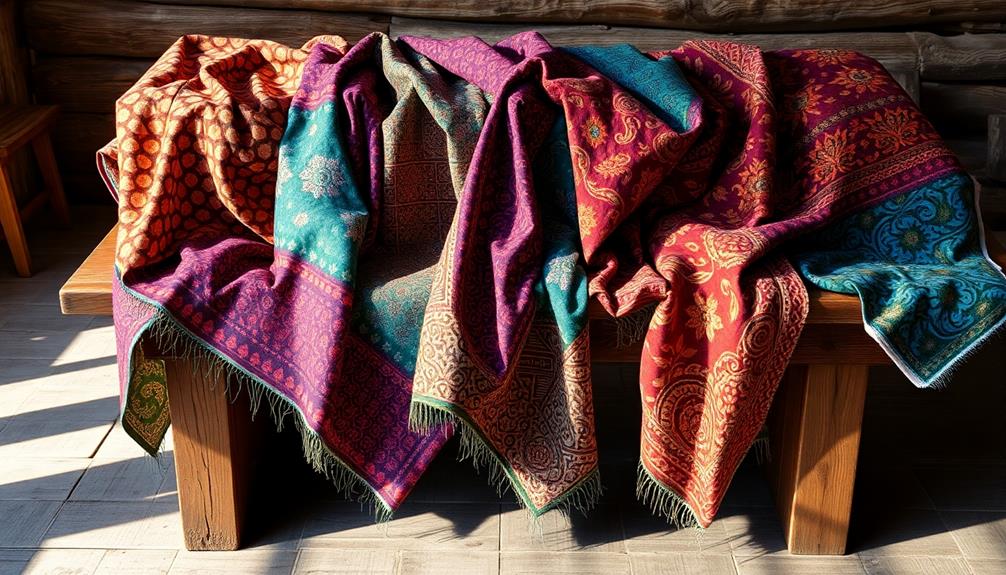
Indonesian fabrics have an enchanting charm that draws people in with their vibrant colors and intricate designs. Among these, batik stands out for its unique wax-resist dyeing technique that creates complex patterns, reflecting the rich cultural significance of Indonesian traditions.
Each batik piece tells a story, often inspired by local history and community values, allowing you to connect with a deep-rooted heritage when you incorporate it into your home. Additionally, the craftsmanship involved in creating items such as the Face Indonesian Decor Mask showcases the artistry that's inherent to Indonesian culture.
But batik isn't the only fabric that captivates. The exquisite songket, woven with gold or silver threads, adds a touch of luxury and signifies wealth and status in Indonesian culture. You can easily see how these fabrics elevate your home decor, transforming spaces into showcases of artistry and tradition.
Moreover, the diverse weaving techniques found across Indonesia, like ikat and tenun, highlight local craftsmanship, with each region contributing distinct motifs that tell unique stories.
Cultural Significance of Batik

Batik's cultural significance runs deep, serving as a form of expression that connects people across Indonesia. Recognized by UNESCO in 2009 as a Masterpiece of Oral and Intangible Heritage of Humanity, Batik embodies the pride and artistry of the nation.
This intricate textile art reflects both social status and personal identity, making it integral to Indonesian cultural heritage. The artistry of Batik is often complemented by traditional decor elements, such as Indonesian decor masks, which enhance the overall aesthetic of a living space.
Here are some key aspects of Batik's cultural importance:
- Symbolism: Patterns often represent wealth, fertility, and spirituality.
- Historical Roots: Used by both royalty and commoners, showcasing social dynamics.
- Regional Diversity: Each area has unique styles, like Batik Pedalaman and Batik Kraton.
- Ceremonial Use: Specific patterns are reserved for significant occasions, such as weddings.
- Cultural Unifier: Batik fosters a sense of belonging among various ethnic groups.
When you incorporate Batik into your home decor, you're not just adding beauty; you're celebrating a rich tapestry of cultural narratives and traditions.
Embrace these patterns, and let them tell the story of Indonesia's vibrant heritage in your living space.
The Art of Batik Creation
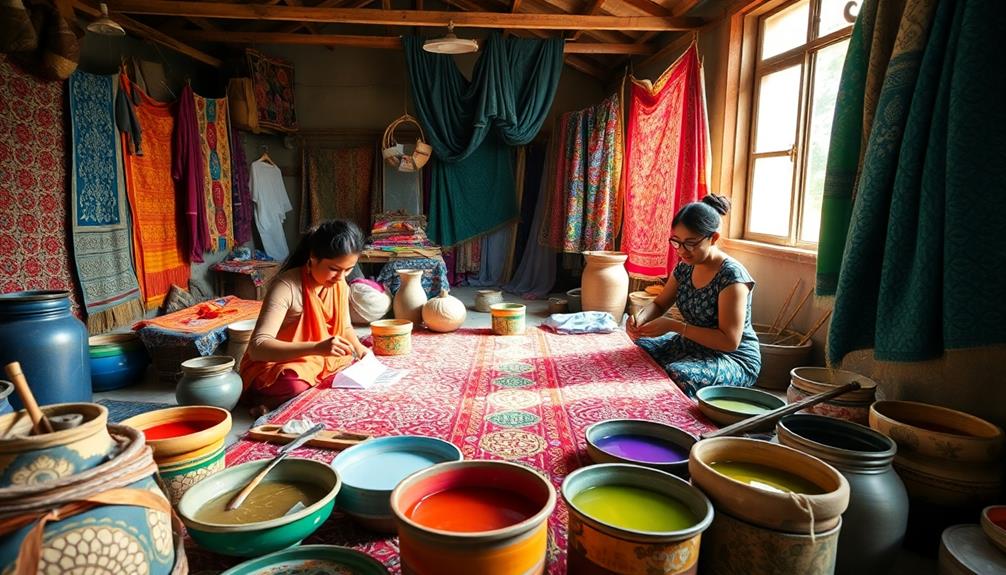
At the heart of Batik creation lies a meticulous wax-resist dyeing technique that transforms plain fabric into stunning artworks. You'll see artisans using a canting tool or block stamp to apply hot wax, allowing for intricate patterns to emerge once the wax is removed.
This process often involves multiple dyeing stages, where the wax is reapplied and removed, resulting in complex designs filled with vibrant colors and details. Additionally, Batik is commonly used in various home decor elements, such as Indonesian Decorative Pillows, enhancing spaces with its cultural heritage.
When you explore Batik, you'll discover that each pattern carries specific cultural meanings. For instance, the parang motif represents strength, while truntum symbolizes love, making each piece not just a textile but a storytelling medium.
The artistry of Batik creation is especially evident in Batik Tulis, which is hand-drawn and labor-intensive, showcasing the artisan's skill and creativity. This type is rare and highly sought after by collectors.
In contrast, Batik Cap uses metal blocks for a quicker, more uniform production method. Regardless of the technique, high-quality Batik is typically crafted from cotton or silk, ensuring that each piece retains its unique charm and cultural significance.
Embrace the beauty of Batik, and let it enrich your home decor.
Types of Batik Explained
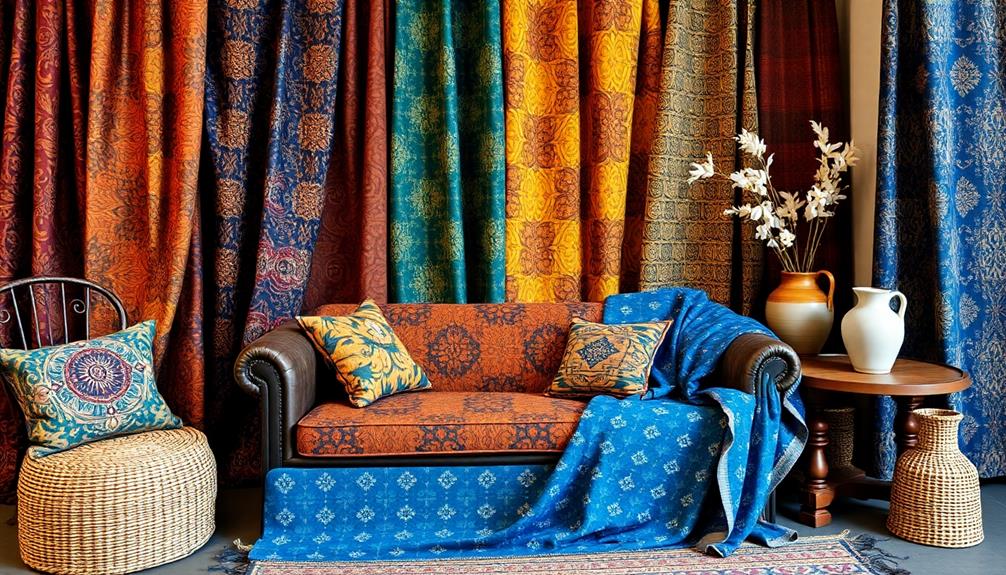
Exploring the world of Batik reveals a variety of styles, each with its unique characteristics and methods of creation. Understanding these types can help you choose the perfect fabric for your home decor, adding a touch of cultural significance that enhances aesthetic appeal.
Here are some popular styles:
- Batik Tulis: Hand-drawn with a canting tool, each piece is unique and labor-intensive, which often makes it pricier.
- Batik Cap: Created using metal stamps, this method allows for faster production and uniform designs, making it more affordable and widely available.
- Batik Pesisir: Originating from coastal areas, this batik features vibrant colors and more relaxed techniques, influenced by cultural exchanges, including the rich cultural heritage of Indonesia.
- Batik Lukis: Involves painting directly on fabric, offering modern interpretations that break away from traditional patterns.
- Batik Belanda: A fusion of Dutch and Javanese traditions, showcasing Western influences on batik art, though its popularity has waned over time.
Unique Features of Sarongs

With their rich cultural heritage and versatility, sarongs stand out as a beloved garment in Indonesian society. These tubular garments, typically made from cotton or silk, feature intricate Batik patterns that reflect both cultural significance and regional styles.
You'll find that sarongs are perfect for tropical climates, easily wrapped around your body for casual wear, formal occasions, or cultural ceremonies. In traditional Indonesian housing, the use of sarongs can often be seen during community gatherings, highlighting their role in social interactions and cultural expression traditional Indonesian housing.
One of the most enchanting aspects of sarongs is the variety of patterns and colors they showcase. Each design can symbolize social status, personal identity, or specific cultural meanings, making every sarong unique to different ethnic groups and traditions.
When you wear or display a sarong, you're not just donning fabric; you're embracing a piece of art that tells a story.
Moreover, sarongs serve as artistic expressions that often incorporate motifs inspired by nature, spirituality, and local heritage. Their increasing popularity in home decor is a demonstration of their charm, as they can transform your space into a vibrant sanctuary.
Whether used as decorative throws, wall hangings, or table coverings, sarongs add a touch of Indonesian culture that enhances your interior decor.
Incorporating Ikat in Decor

When you incorporate Ikat into your decor, you're bringing in unique patterns and textures that truly stand out.
These vibrant fabrics reflect the diverse architectural styles of Indonesia, adding a touch of cultural heritage to your home.
They work well in various spaces, whether you're dressing up throw pillows or adding flair to curtains.
Plus, each piece carries cultural significance, connecting your home to the rich heritage of Indonesia.
Unique Patterns and Textures
Ikat fabrics bring a vibrant touch to your home decor, showcasing unique patterns and textures that tell rich cultural stories.
This traditional Indonesian weaving technique features threads dyed before weaving, resulting in stunning designs with characteristic blurred edges. These distinctive traits not only enhance the visual appeal of your space but also reflect the cultural significance behind each piece.
Incorporating Ikat into your decor can beautifully complement Balinese design characteristics that emphasize a connection to nature and craftsmanship.
Here are some reasons to incorporate Ikat into your decor:
- Cultural Depth: Each pattern represents local myths and traditions, adding meaning to your home.
- Visual Interest: The intricate designs create bold focal points in any room.
- Unique Textures: The resist-dyeing process gives Ikat a tactile quality that elevates your decor.
- Sustainable Choice: Supporting traditional weaving techniques promotes sustainable practices.
- Regional Variety: Different regions in Indonesia offer diverse Ikat styles, allowing for personalized decor choices.
Versatile Usage in Spaces
Incorporating Ikat fabrics into your home decor opens up a world of versatile design possibilities. Known for their vibrant colors and unique patterns, Ikat can serve as a stunning focal point in any room. You can use Ikat for upholstery, curtains, or accent pillows, effortlessly enhancing your space's aesthetic.
This aligns beautifully with the principles of traditional Indonesian style home decor, where natural materials and intricate textiles play a key role in creating a warm and inviting environment.
Mixing Ikat with solid colors and minimalist furniture creates a harmonious balance between traditional craftsmanship and modern design. Its adaptability allows you to seamlessly integrate Ikat into various interior styles, from bohemian and eclectic to contemporary and rustic.
Whether you're aiming for a casual or formal atmosphere, Ikat can elevate your home decor.
Consider using Ikat as wall art or framed pieces to transform a plain wall into an artistic showcase. This not only adds depth to your decor but also highlights the rich heritage and craftsmanship behind the fabric.
With Ikat, you're not just decorating; you're telling a story through your home decor choices. So go ahead, let the versatility of Ikat inspire you to create a stylish, inviting space that reflects your unique taste and appreciation for cultural artistry.
Cultural Significance and Heritage
How does the rich cultural heritage of Indonesia influence the beauty of your home decor? Incorporating ikat fabrics not only enhances your space but also connects it to a deeper narrative.
These traditional textiles are woven using a unique technique where threads are dyed before weaving, resulting in stunning patterns that reflect local myths and nature. The use of intricate fabrics, such as traditional motifs and patterns, adds a distinctive touch that enhances the cultural significance of your decor.
Here are some key aspects of ikat's cultural significance:
- Symbol of Social Status: Historically, ikat fabrics represented social standing within communities.
- Ceremonial Purposes: Often used in rituals and celebrations, ikat adds a layer of meaning to your decor.
- Artistic Expression: The vibrant colors and intricate designs serve as striking focal points, showcasing Indonesian artistry.
- Cultural Depth: Each piece tells a story, enriching your home with heritage.
- Versatile Applications: Use ikat in upholstery, curtains, cushions, or wall art for creative expression.
The Elegance of Songket
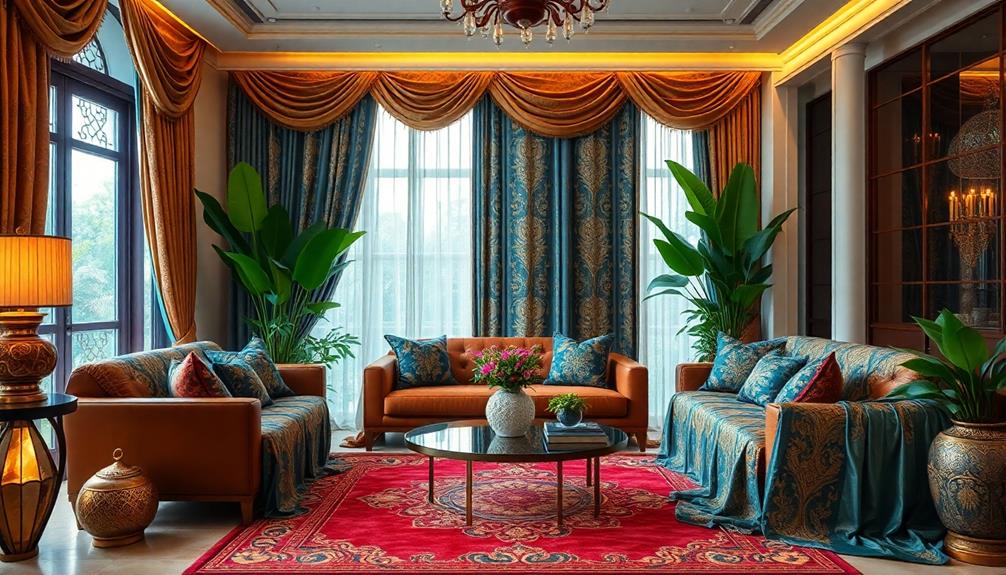
You can't help but admire the elegance of Songket, a fabric that embodies Indonesia's rich cultural heritage.
With its intricate patterns and luxurious gold or silver threads, each piece tells a story through traditional weaving techniques mastered by skilled artisans.
The use of natural materials in its creation reflects the deep connection to the environment that's characteristic of Southeast Asian decor.
Incorporating Songket into your home decor not only adds beauty but also honors the deep significance of this remarkable craftsmanship.
Cultural Heritage Significance
Songket fabrics embody the rich cultural heritage of Indonesia, showcasing elegance and artistry that captivate anyone who encounters them.
These textiles aren't just beautiful; they hold deep significance in Indonesian culture, representing a blend of history, craftsmanship, and identity.
Here are some key aspects of songket's cultural heritage significance:
- Traditional Weaving Techniques: Songket is crafted using intricate methods passed down through generations.
- Symbols of Wealth and Status: Historically associated with royalty, wearing songket signifies prestige in society.
- Cultural Identity: Each motif tells a story or reflects local values, connecting you to the region's heritage.
- Ceremonial Importance: Songket plays a crucial role in weddings and significant life events, symbolizing unity and tradition.
- Heirloom Value: These fabrics are often cherished as family treasures, preserving the artistry for future generations.
Design and Weaving Techniques
The elegance of songket lies not just in its stunning appearance but also in the intricate design and weaving techniques that bring it to life. This traditional Indonesian fabric, often woven with gold or silver threads, showcases patterns that symbolize wealth and status, particularly in cultural ceremonies.
You'll find that songket's weaving techniques are unique, employing a supplementary method that allows metallic threads to blend seamlessly into the fabric, creating a luxurious texture.
Originating primarily from Sumatra, songket varies by region, with styles like Songket Lombok boasting colorful cotton and Songket Palembang showcasing natural fibers and silk. Each style reflects local artistry and cultural values, adding to its allure.
As you explore songket, you'll notice the intricate patterns often depict floral and geometric designs, rich with meanings tied to the identity and heritage of the communities that create them.
While batik is also a significant Indonesian fabric, songket stands apart with its shimmering threads and deep-rooted symbolism. Integrating songket into your home decor not only elevates its aesthetic appeal but also connects you to the rich cultural tapestry of Indonesia.
Ulos: Symbolism and Uses

Ulos fabric, a vibrant symbol of Batak culture from North Sumatra, plays an essential role in various ceremonies and rituals. This traditional textile, often woven by hand, carries deep cultural significance and serves multiple purposes, especially as ceremonial attire.
Here are some key aspects of Ulos:
- Ceremonial attire: Worn during weddings, funerals, and significant life events.
- Symbolism of social status: Represents the wearer's place within the community.
- Intricate designs: Bold patterns convey meanings related to unity and protection.
- Cultural heritage: Designated as intangible cultural heritage in 2014.
- Gift-giving: Often presented during important occasions as a sign of respect.
The Ulos fabric not only enhances the beauty of your home decor but also brings a touch of history and tradition.
By incorporating Ulos into your living space, you're celebrating the Batak community's rich heritage.
Its unique patterns and colors can transform your environment while reminding you of the values of unity and respect that the fabric embodies.
Embrace the magic of Ulos, and let it tell its story in your home.
Modern Trends in Textile Design
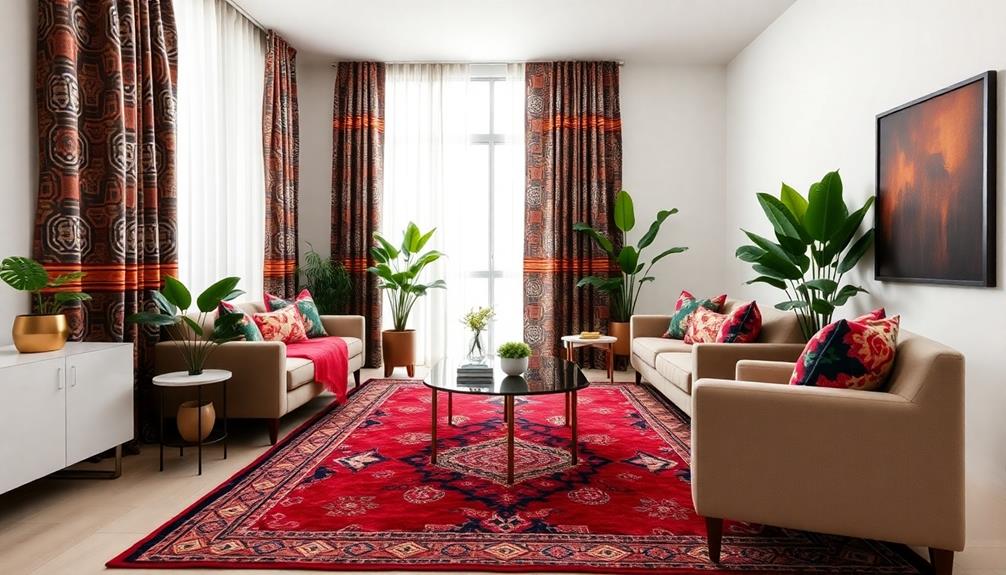
In today's world of home decor, modern textile design is seamlessly merging traditional craftsmanship with contemporary flair. You'll find that textiles like batik and ikat are gaining traction, as they blend rich cultural heritage with modern aesthetics.
These fabrics become striking focal points in your living space, showcasing intricate patterns and bold colors that capture attention.
Sustainability is another key trend in textile design. Homeowners are increasingly seeking out sustainable materials and eco-friendly production methods, ensuring their decor choices aren't only beautiful but also responsible.
By choosing textiles made from organic or recycled materials, you contribute to a healthier planet.
Customization is revolutionizing how you personalize your space. Now, you can select specific motifs and colors that resonate with your style and cultural ties, allowing your home decor to truly reflect who you are.
Technology plays a significant role here, too; digital printing techniques enable you to reproduce detailed patterns on fabrics efficiently, minimizing waste.
With these modern trends, your home can effortlessly showcase a unique blend of tradition and innovation, making your decor not just stylish but meaningful.
Sourcing Authentic Indonesian Fabrics
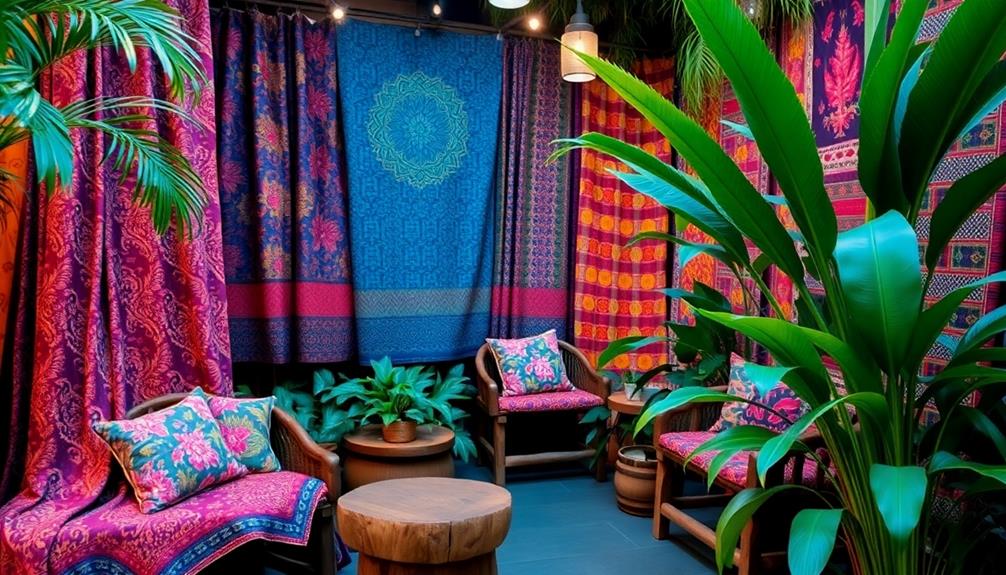
When you're sourcing authentic Indonesian fabrics, it's essential to prioritize authenticity to guarantee you're getting high-quality textiles that reflect true cultural heritage.
You can find these genuine pieces through reputable suppliers like ABM Wholesale Indonesia, which specializes in traditional textiles.
Importance of Authenticity
Sourcing authentic Indonesian fabrics is essential for anyone looking to enhance their home decor with textiles that tell a story.
By choosing authentic fabrics like Batik, Ikat, and Songket, you're not just decorating; you're embracing a piece of Indonesia's rich heritage.
Here's why authenticity matters:
- Cultural Significance: Each fabric carries deep cultural meanings and traditional artistry.
- Quality Craftsmanship: Authentic pieces are often made using traditional crafting methods passed down through generations.
- Support Local Artisans: Purchasing genuine textiles helps promote sustainable livelihoods for weaving communities.
- UNESCO Recognition: Authentic Batik features intricate wax-resist dyeing, celebrated for its vibrant colors and complex patterns.
- Traceability: Look for reputable suppliers who share the fabric's origin and production methods.
When you invest in these unique textiles, you're ensuring that your home decor reflects not only beauty but also respect for the artisans and their craft.
Where to Find
Finding authentic Indonesian fabrics is easier than you might think. Local markets are treasure troves for beautiful textiles like batik, ikat, and songket.
In Yogyakarta, for instance, Pasar Beringharjo offers a wide selection of these fabrics, while Pasar Tanah Abang in Jakarta is known for its vibrant array of choices. Exploring these markets not only allows you to find unique pieces but also lets you engage with the local culture.
If you're looking for convenience, online platforms like ABM Wholesale Indonesia provide access to genuine Indonesian fabrics, focusing on quality and cultural significance.
Many artisans and cooperatives across Bali and Lombok offer handmade fabrics directly through workshops and cultural centers, preserving traditional techniques.
Consider attending textile fairs or cultural festivals, such as Indonesia Fashion Week, where you can connect with local designers and discover unique collections.
You'll be supporting sustainable practices while enriching your decor. Additionally, websites and social media pages dedicated to Indonesian textiles often showcase curated selections, making it easier to find original pieces while learning about their cultural backgrounds.
Frequently Asked Questions
What Is the Traditional Fabric of Indonesia?
Indonesia's traditional fabrics include Batik, Ikat, Songket, and Tenun. Each showcases unique patterns and techniques, reflecting cultural heritage. By exploring these fabrics, you'll appreciate their rich histories and significance in Indonesian society.
What Is the Indonesian Textile Technique?
Did you know that over 30 traditional textile techniques exist in Indonesia? You'll find incredible methods like Batik, which uses wax-resist dyeing, and Ikat, where dyed threads create stunning patterns. Each technique tells a unique story.
What Is the Most Famous Textile of Indonesia?
The most famous textile of Indonesia is Batik. You'll appreciate its intricate patterns and cultural significance, often reflecting local history. It's a stunning example of artistry, recognized by UNESCO for its unique wax-resist dyeing technique.
What Is the Indonesian Method of Painting on Cloth?
The Indonesian method of painting on cloth is called Batik Lukis. You'll see vibrant designs created by applying dyes directly onto fabric, allowing for unique patterns and creative expression that stand out in textile art.
Conclusion
As you weave Indonesian fabrics into your home decor, imagine the vibrant hues of batik swirling like a sunset across your living room. Feel the soft embrace of a sarong draping elegantly over a chair, whispering tales of tradition. Let the intricate patterns of songket shimmer like stars on your walls, while the rich symbolism of ulos wraps your space in warmth and culture. Embrace the magic of these textiles, and transform your home into a tapestry of artistry and heritage.




